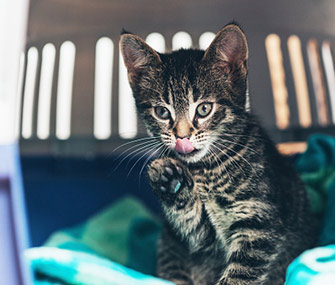The Survival Guide to Traveling Cross-Country With Your Cats
Published on March 14, 2016
Skip To

Moving cross-country with a cat may seem daunting, but lots of people do it and survive to tell the tale. But what about people who are on the road all the time — with their cats? Truckers and RVers often find cats to be purr-fect traveling companions. They’re clean and quiet (usually) and have been known to alert their human companions to weather changes or warn them of trouble. One trucker recalls his cat waking him in the middle of the night and discovering thieves making off with his hubcaps.
An adventurous cat is the best choice for an on-the-road-again lifestyle, but just about any cat can adapt to life on wheels. You may even find that your cat enjoys it more than snoozing on your sofa. Start slowly by first getting him comfortable with being in his carrier, then taking brief trips to accustom him to his new surroundings and see how he adjusts.
If you’ve ever thought of taking your tabby on the road, here are some tips to get you started.
Safety First
It’s not unusual to hear of cats who ride curled up on the dashboard or in the rear window area of a car or who have free run of the vehicle. It might seem cute to let your kitty stretch out in the sunshine, but it’s just not safe for the cat — or the passengers. If you had to stop suddenly or were in an accident, your cat could wind up airborne and be seriously injured or killed as a result, or he could seriously injure you. He can also pose a distraction to the driver if he’s roaming free while you’re out on the highway.
Instead, have your kitty ride in a hard-sided crate lined with a comfy bed. If you think he would prefer to watch the road roll by, set up a pet booster seat with an attachment to keep the crate safely restrained while the vehicle is moving.
When Nature Calls
What about a litterbox? Feed your cat first thing in the morning, at least an hour before you depart, and give him a chance to do his business before you set out. According to Dr. Ilona Rodan, the average healthy cat will likely not need the litterbox again until you’re ready to stop for the day. “My 16-month-old kitten did not use a box for 18 hours [during a trip] and did not act upset or as if he needed a box,” says Dr. Rodin. “Clients who took cats to Japan have also said that their cats have never urinated or defecated on the way to or from.” But each cat is unique, so if you stop for a lunch break, it’s still a good idea to give your cat access to the litterbox.If your cat has a medical condition that necessitates more frequent litterbox usage, take advantage of the many disposable cardboard litterboxes that are available. Fill plastic bags with portions of litter to fill boxes as needed. If possible, toss the box once your cat is done with his bathroom break — otherwise, store it in an airtight bag and dispose of it once you reach your destination. And consider introducing your cat to the disposable litterbox before you start on your cross-country journey — the more familiar with it he is, the more likely he is to use it on the road.
It’s also important to give your cat fresh drinking water throughout the day.
Exercise on the Road
After sitting in your car or RV all day, it can feel good to move around. The same goes for your feline. Before you set out to see America, consider teaching your cat to walk on a leash. Not every cat will take to this, but many do, and it’s a great way to give your cat some exercise and entertainment wherever you stop or stay. But keep in mind that cats can back or squirm out of a harness, so make sure it fits snugly. Your cat should also have ID tags with your cell phone number and a microchip with current contact information.If your cat is just not into the leash, consider a covered wire exercise pen. Set it up outside your RV or campsite so your cat can safely stretch and sun himself. Be sure to supervise him at all times, though, to guarantee that he doesn’t get out or a predator doesn’t get in.
Of course, before you hit the road, talk to your veterinarian about the trip and your final destination. She’ll make sure your cat is current on appropriate vaccinations and parasite control for that region of the country. And she might even offer additional suggestions to help your cat have a safe and comfortable trip.
More on Vetstreet:





